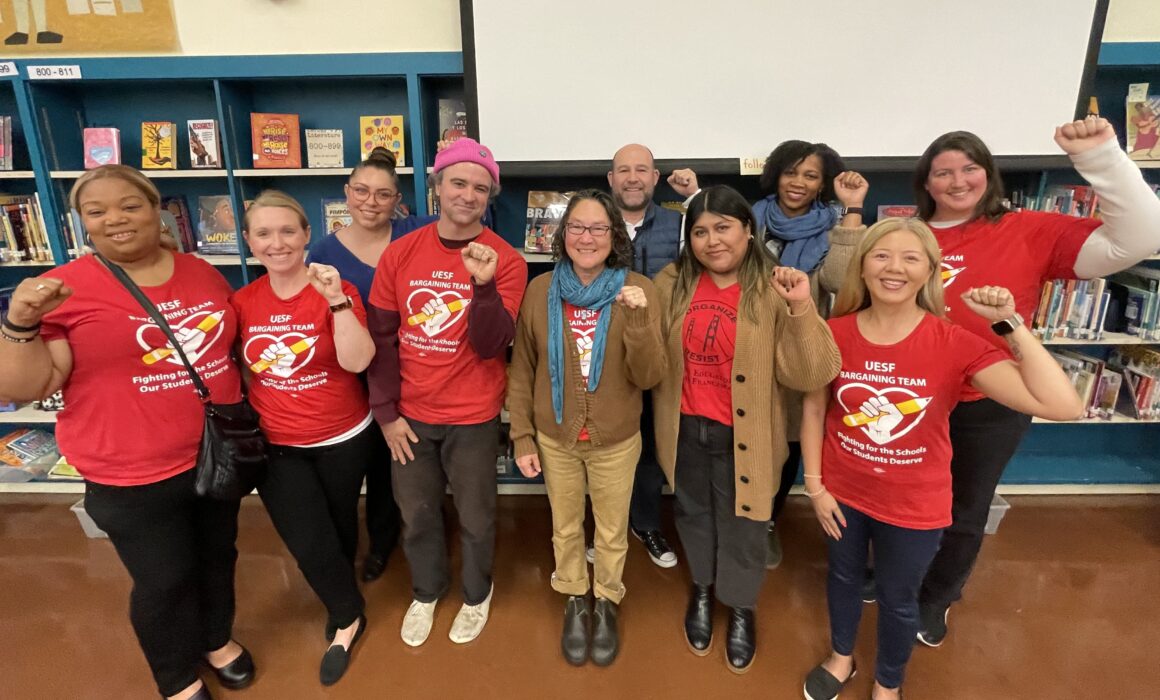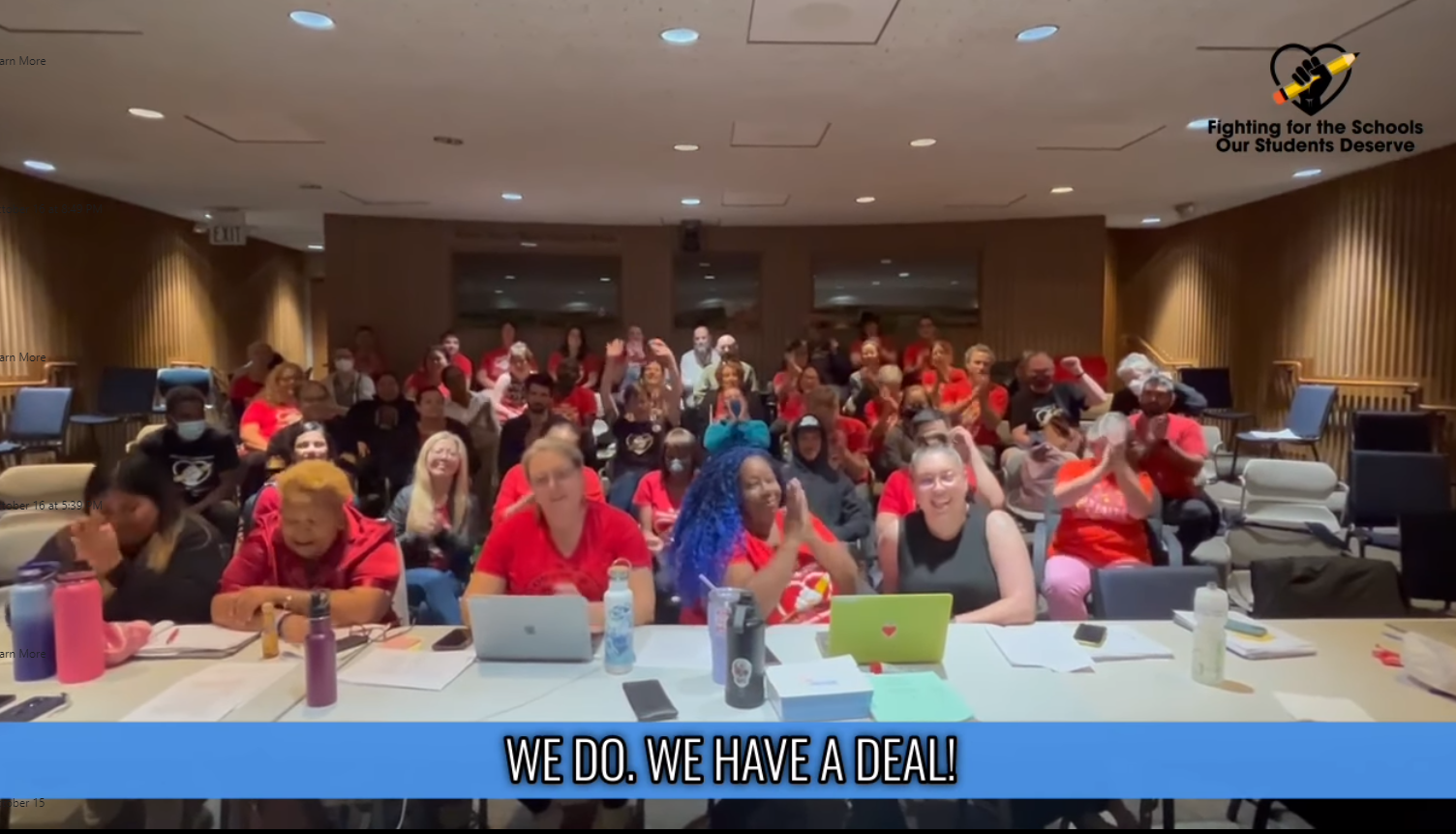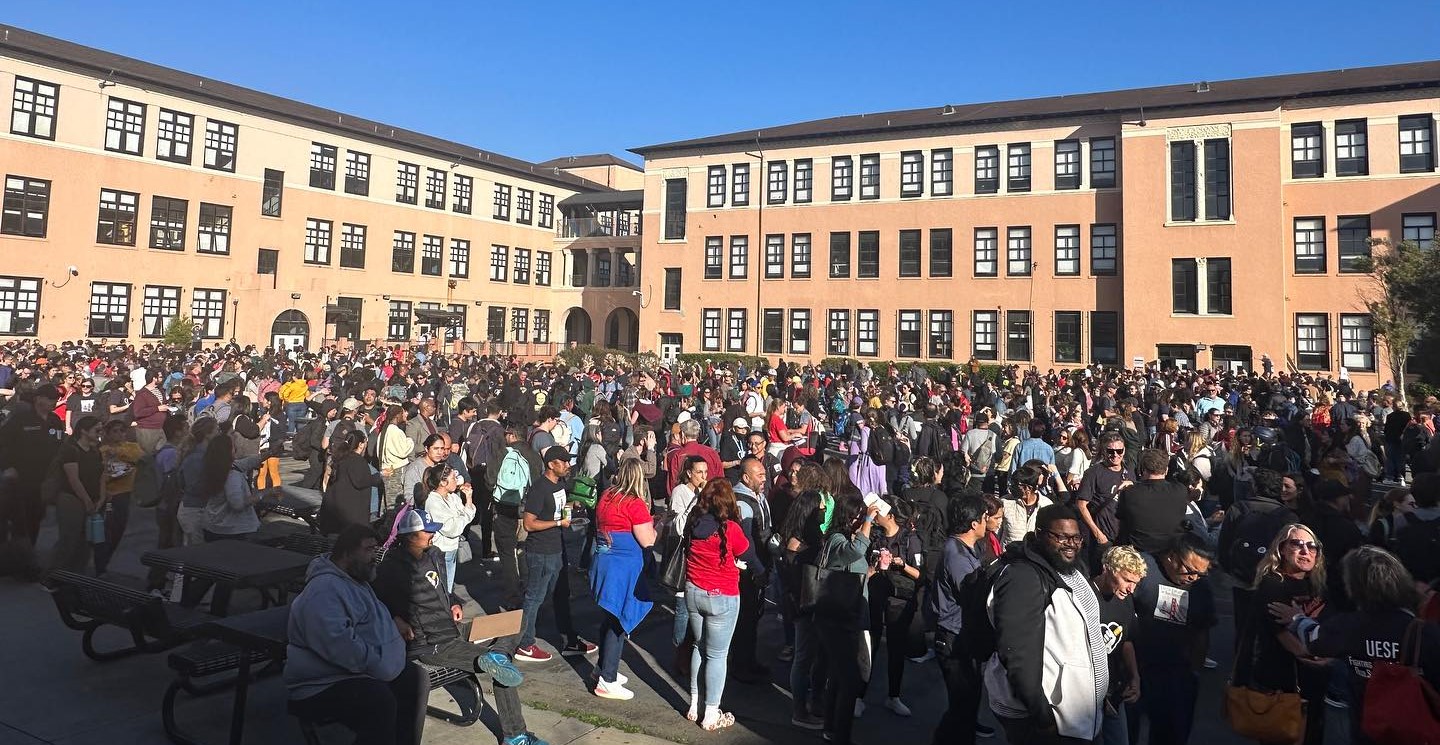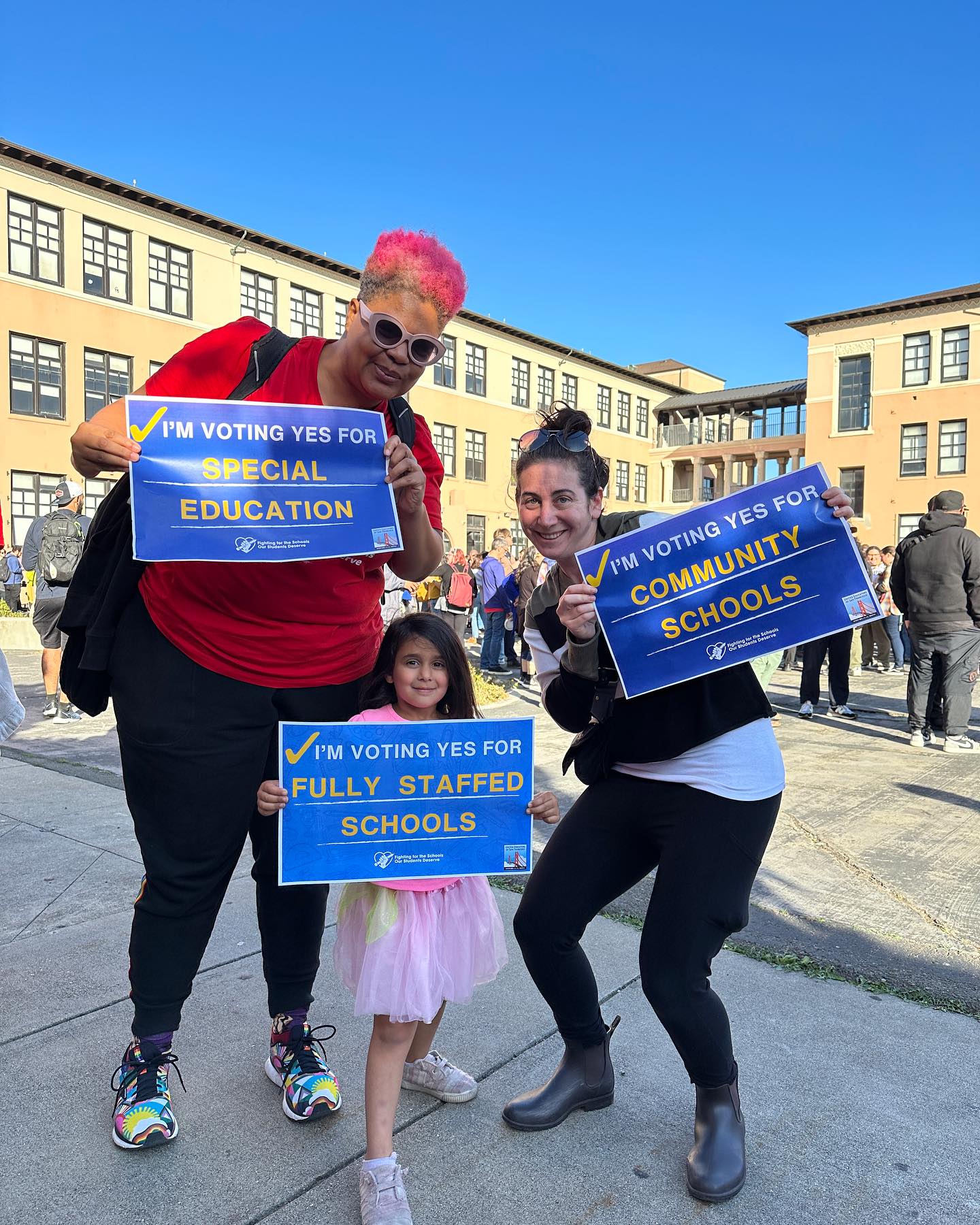
“EVERYTHING CHANGED in this bargaining campaign,” says paraeducator Teanna Tillery. “It was exciting to be on a big bargaining team that had all our voices from different sites. We all truly felt like we were part of the process, and it made a difference.”

UESF’s Big Bargaining Team, announcing on Facebook Live that they reached a tentative agreement.
When United Educators of San Francisco (UESF) went into contract negotiations last March, leaders knew they wanted to bring an expanded bargaining team to the table to include all the large local’s voices. But they were unaware just how much that would change their understanding of each other, alter their approach for the bargain and build power as a union.
UESF is one of the larger locals in CTA, representing a wide array of staff in San Francisco Unified School District, including credentialed educators, education support professionals (ESPs) and substitute teachers. In all, UESF represents about 5,000 credentialed and 1,500 classified members. After bargaining in 2020 with a team of 25, UESF leaders wanted to expand even larger to create a team where all members felt their voices and needs were at the table.
UESF President Cassondra Curiel says expanding the bargaining team to 65 was a deliberate decision rooted in equity to build a foundation of solidarity and accomplish their shared goals.
“It wasn’t just having 65 people on the team, there was intention,” Curiel says. “It represented a lot of places and spaces.”
The big number had its challenges. “It was a relief to have many hands making light work. More voices and shared decision-making were huge, but also hard sometimes,” says UESF Executive Board member Darcie Chan-Blackburn.
“This contract is transformative for the students of San Francisco, even the ones who aren’t students yet. At every school site, we are united to make things better for the long-term.” – UESF President Cassondra Curiel
At the campaign kickoff, union leaders including the bargaining team shared their experiences in their specific roles in schools, the challenges they faced and their priorities for the bargain. After many words of appreciation for their work, paraeducators revealed some of the many inequities they faced at the district, including disparate longevity pay and the lack of a pension for the lowest-paid and most racially diverse group of members. It was a powerful and emotional moment for the team.
“And they immediately pivoted and made us their priority. It went from ‘I’ to ‘we’ — the bargain was like a birth of our union,” says Tillery. “If I didn’t know we were one union before, I do now.” School social worker Yajaira Cuapio called it “a moment of class consciousness” for UESF — one that changed their approach and made them stronger than ever before.
“I think it really transformed us all. It definitely changed me and the way I identify as a worker and leader,” Cuapio says. “It taught me more about San Francisco and our society. We’re talking about touching community.”
Teacher Anaia Gilliam says learning about how many of her colleagues were living and existing was eye-opening. Through this lens, the bargaining team developed a series of proposals rooted in equity. Rather than traditional across-the-board percentage increases that give the lowest raises to the lowest paid, the team sought to lift the salary schedule from the bottom, fighting for dignity and a basic standard of living for all UESF members. Gilliam says they even looked at current gaps in equity and anticipated places where district admin would try to divide the union.
“Equity became an important anchor, so we got what the general membership needed at the table,” she says. “It was a learning experience. I hadn’t previously considered others in the unit — I learned about my colleagues in a way I hadn’t before.”
Special education instructional aide Alex Schmaus says they thought strategically about what it means to be a union that is centered in inclusion and unity, including understanding that collective action is higher stakes for ESPs, who often are living close to the edge.
“ We set a goal of equity from the beginning. We’re trying to lift a section of our membership out of poverty,” says Schmaus. “This is a path we have to walk for a few cycles, but it’s in sight now.”
Since 1996, paraeducator longevity pay had been stagnant at an additional 30 cents an hour after 10 years of service to the district, different than the usual percentage pay increases provided to veteran staffers. This disparate approach to recruiting and retaining quality paraeducators showed a lack of value for these educators and the important services they provide to San Francisco students.
The bargaining team embraced the idea that making meaningful improvements to paraeducator pay is a special education issue and struck a huge victory for equity, including percentage-based longevity increases for paraeducators and an SFUSD where no classified employee makes less than $30 an hour.
“When we say solidarity or equity, our actions match our words,” Curiel says. “Our work is easier when we have fully staffed schools. Stable schools mean better working conditions, for all of us.”
Tina Leung, a bilingual speech language pathologist, says it was powerful for the team to build their proposals together and gain an understanding of how it would impact all members. They were deliberately transparent and communicated the goals of the bargain to empower members to fight and win. And when the union made these proposals to the district, UESF members gave testimony and told their stories to humanize the proposals, bringing organizing to the bargaining table.
“So the district’s first engagement with our proposals was with the stories from members,” Curiel says. “It’s about us every day — not the contract language on paper.”
Winning the information battle early was key to building power, which was in full display when UESF members voted to authorize a strike with 97% approval (see sidebar). Bargaining team members said it was transformative how much UESF’s strength grew in only a year.
“And it was all very intentional growth,” says special education paraeducator Diana Mueller. “We were meeting and building power at our worksites and getting everyone involved. Our victory was a culmination of that work.”
The Strike Vote: A Show of Unity and Power

Thousands of UESF members converged on Balboa High School for a strike authorization vote in October.
After six months of bargaining with a district administration that didn’t seem interested in recruiting and retaining quality educators, UESF held a strike authorization vote in mid-October 2023 that showed just how ready members were to fight for their students and each other. Thousands of educators converged on Balboa High School that afternoon, forming a massive serpentine line that coiled back and forth across the campus in a powerful display of unity, and a promise to admin that UESF was ready to strike if necessary.
“People were showing up before contract hours were up, so it was almost like a job action,” says Alex Schmaus, a special education instructional aide and UESF Bargaining Team member. “It wasn’t just the numbers; it was the membership showing us they were ready to fight and also wanting to fight.”
When the votes were tallied, 97% had voted to authorize a strike to win the schools that San Francisco deserved. Bargaining team member Jeffrey Finger says the turnout was a loud message to not blink at the bargaining table.
The tone at the table changed after the strike vote, with admin getting more serious about the bargain and taking a more collaborative approach. In a matter of weeks, the district’s offer improved dramatically — for certificated educators alone, the offer went from a one-year, $5,500 raise to a two-year offer with a $9,000 raise the first year and 5% the second.
“We were very far apart for months and months, and then we had the strike authorization vote and they were throwing money at us,” Schmaus says.
“Look at how far the district came in such a short time — and that’s because of organizing,” Finger adds.
What They Won

UESF members were committed to each other and ready to fight for better, authorizing a strike with a 97% vote.
UESF’s Big Bargaining Team won a tentative two-year agreement on Oct. 20 at 6 a.m. after a 13-hour marathon bargaining session. Approved by 86% of UESF members, highlights of the contract include:
• All ESPs will earn a minimum salary of $30 an hour in the first year of the contract (with ESPs earning more than that receiving an 8% raise), and a 5% pay increase in the second year.
• ESPs will now receive percentage longevity pay increases at 5, 10, 15 and 20 years.
• The average pay increase for ESPs is 39% (or $10.37 per hour)
• Certificated educators will receive a $9,000 on-schedule pay increase the first year and a 5% raise the second year. The average increase to annual salary for certificated educators for this agreement is 19.4%.
• Substitute educators: The first-year sub rate is $316 per day with an additional 5% in the second year, while 160-day QTEA (Quality Teacher & Education Act) subs will receive $80 more per day.
• New contractual community schools language, including a districtwide steering committee and a requirement for a community school coordinator.
• Won gains that will help all UESF members deal with inflation and the cost of living in the San Francisco Bay Area while also helping to recruit and retain the educators desperately needed to stabilize their schools.
• Additional wins include gains for fully staffed schools, improved working conditions, student support, protections from poor management decisions (such as with payroll, benefits and retirement), and special education.
The Discussion 0 comments Post a Comment